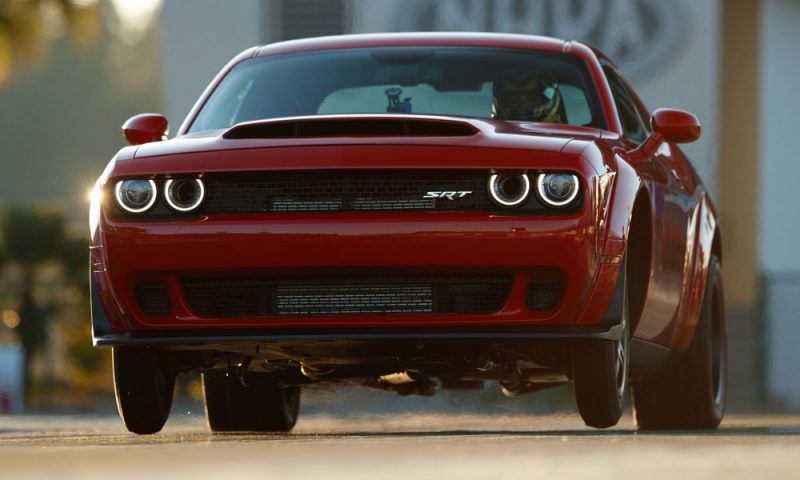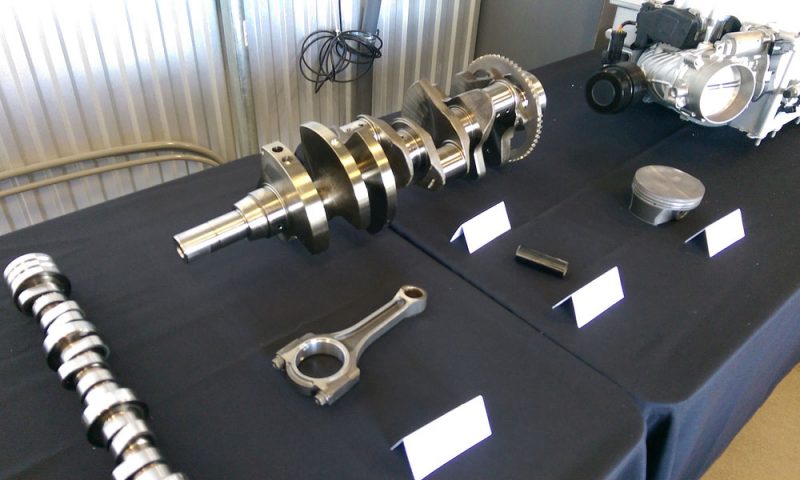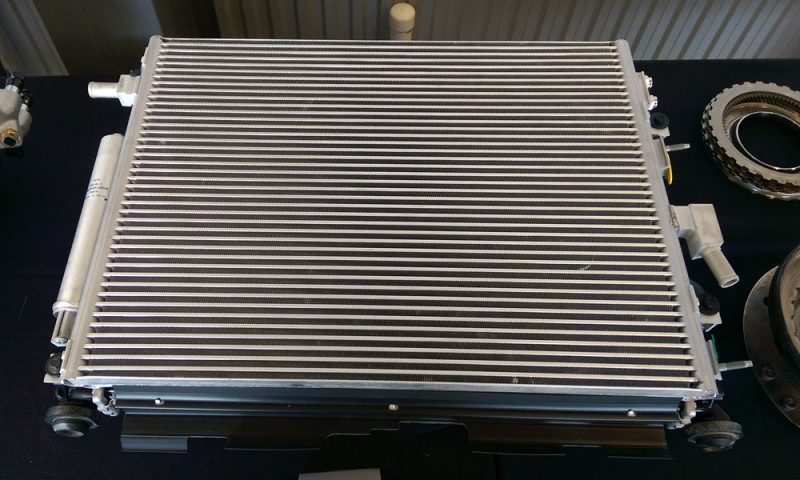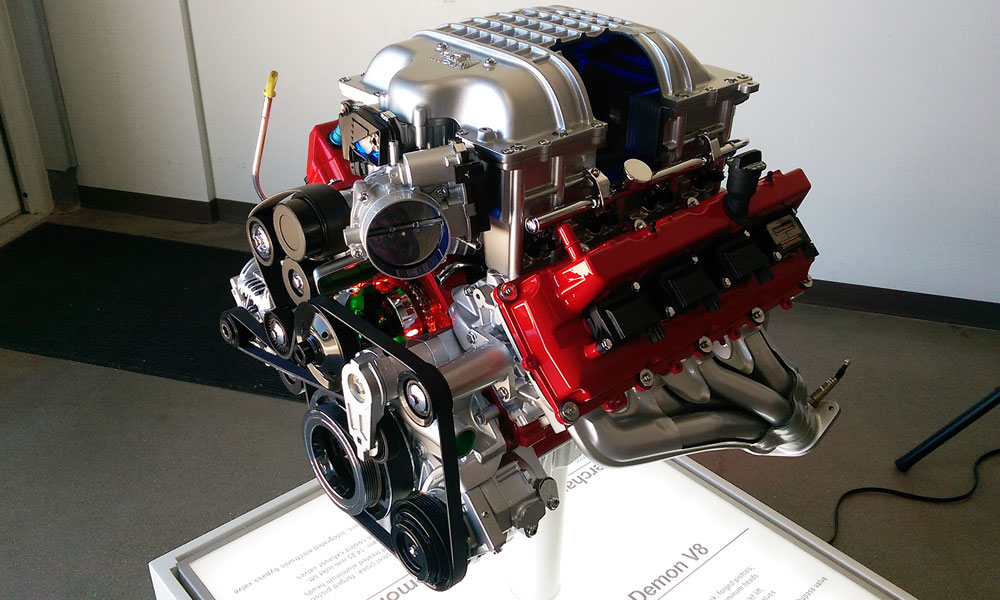In the summer of 2015, with car enthusiasts in awe of the performance of the newly introduced supercharged Hellcat V-8 engine (707 horsepower, 650 pounds-feet of torque) in the Dodge Challenger SRT and Charger SRT, FCA Powertrain and Dodge planners began to ponder “what’s next.”
Following a route carved by the Dodge Viper ACR as a street-legal version of the ultimate track car, thoughts turned to transforming the Dodge Challenger into a street-legal version of the ultimate drag strip car.
That car, the 2018 Dodge Challenger SRT Demon, made its public debut in early April at the New York International Auto Show after a unique, three-month teaser campaign that disclosed many of the car’s innovative features. Yet the car’s performance numbers – 840 hp on 100-octane unleaded fuel, 808 hp on premium 91-octane fuel, running the quarter-mile in 9.65 seconds at 140 mph – were known only to a handful of people until less than an hour before the car was revealed.
With production of the 2018 Dodge Challenger SRT Demon slated to begin later this year, Tim Kuniskis, Head of Passenger Car Brands – Dodge, SRT, Chrysler and FIAT, FCA – North America, and Chris Cowland, Director of Advanced and SRT Powertrain Engineering, recently talked about details of the record-setting car’s powertrain and how it was developed inside FCA for two years without attracting much attention.
Some of those details:
- To meet the original goal of a car that would run the quarter-mile in 10 seconds, Cowland’s team calculated the engine needed at least 10% more horsepower and 20% more launch force. So the original target for the Demon V-8 was 777 hp.

The 2018 Dodge Challenger SRT Demon is a certified world-record holder for a production car to pop a wheelie.
- As the team developed the Challenger SRT Demon, the goal became “9s with light,” Kuniskis said, meaning a car that ran the quarter-mile in less than 10 seconds and did a wheelie at launch to let light shine underneath the front wheels. Anything that did not help meet that goal was deleted from the project.
- Based on the bill of materials, 62% of the Demon V-8 is new compared with the Hellcat V-8. Major changes were made to the engine block, crankshaft, pistons and connecting rods, and the supercharger.
- Previous powertrains carried code names adopted from military aircraft. To avoid attracting attention, Cowland codenamed the Demon V-8 “Benny,” drawn from the Benny the Ball character in the “Top Cat” cartoon series from the early 1960s.
- Benny the Ball is blue and Cowland wanted the Demon V-8 to be painted blue, but that color did not exist in the validated powertrain paint color palette. So Demon V-8s are painted red.

The piston and crankshaft of the Demon V-8 were strengthened to handle the increased force of the 840-hp supercharged 6.2-liter engine.
- Each piston in the Demon V-8 is loaded with 11 tons of force on each power stroke, equal to the weight of five Dodge Challengers. This happens more than 50 times a second on each piston. Each cylinder handles up to 1,957 pounds per square inch of pressure.
- Cool air is a key factor in the Demon V-8, creating its impressive power. The triple-inlet air induction includes the 45-square-inch functional Air-Grabber™ hood scoop.
- The SRT Power Chiller™ diverts air conditioning refrigerant from the cabin to the chiller unit, reducing the charge air temperature by 18 degrees Fahrenheit.
- The Challenger SRT Demon’s driveline sees 11,164 pounds-feet of torque at launch. The car’s prop shaft, halfshafts and differential were strengthened to handle the force.
- The specially tuned adaptive damping system transfers 2,576 pounds from the front to the rear wheels at launch. TransBrake and torque reserve maximize torque and boost at launch.
- During a quarter-mile run, the Demon V-8 takes in 173 cubic feet of air. That equals the lung capacity of 816 humans. The engine would drain the Challenger’s cabin of air in 800 feet.
- The Demon V-8 was tested in dynamometer cell C07, one of two cells built to test NASCAR racing engines. Operators tested the engine on weekends and at night to avoid attracting attention. Also, the test cell’s instruments were recalibrated to display Hellcat performance data.
- At rated power, the Demon V-8 uses 1.6 gallons of fuel per minute. A typical shower flows at 2 gallons per minute. To supply the amount and pressure of fuel needed, a second in-tank pump was added to the Challenger SRT Demon’s fuel tank.
- The project was referred to only as Challenger Special Edition or Challenger SE in meeting notices to keep its true objectives under wraps, Kuniskis said. Project data was kept on a separate computer location with access limited to few people.

The front end cooling module helps the 2018 Dodge Challenger SRT Demon manage the heat generated by the supercharged V-8.
- The heat generated by the engine at rated power would bring a quart of room-temperature water to boil in 1.2 seconds.
- Every Demon and Hellcat V-8 is dyno tested under load for 42 minutes at the engine plant in Saltillo, Mexico, before being shipped to the assembly plant in Brampton, Ontario.
Starting later this year, be alert for a new top performer at drag strips – the 2018 Dodge Challenger SRT Demon.




